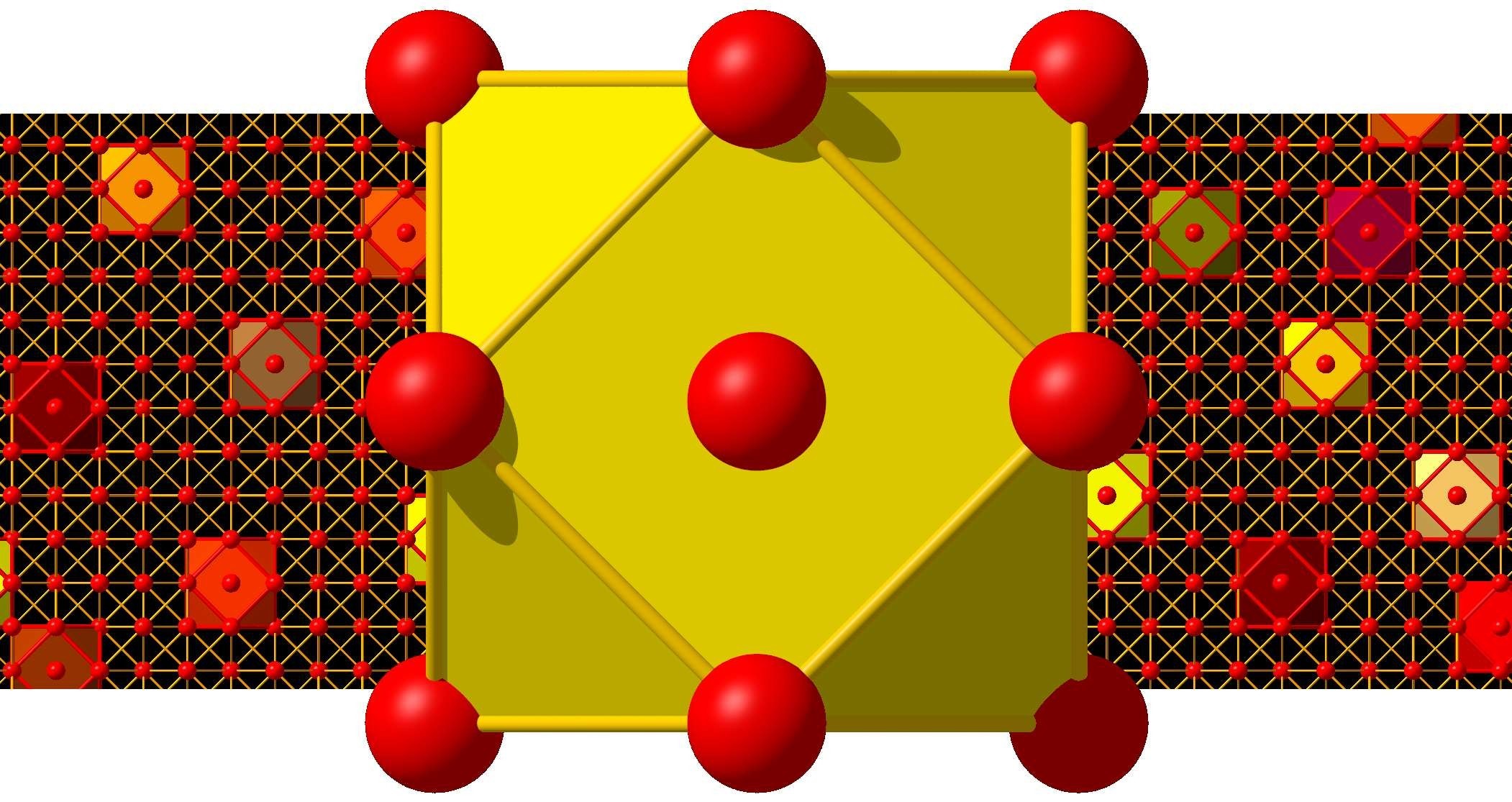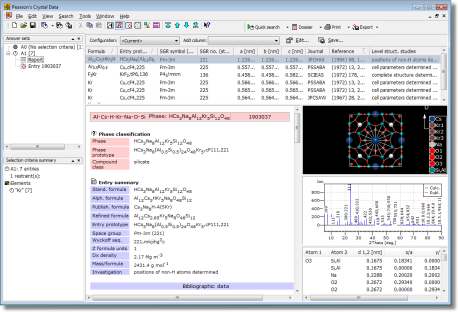Pearsons Crystal Data Crystal Structure Database for Inorganic Compounds Pearsons Crystal Datais a crystallographic dat...
Pearson's Crystal Data
Crystal Structure Database for Inorganic Compounds

Pearson's Crystal Data is a crystallographic database published by ASM International (Materials Park, Ohio, USA), edited by Pierre Villars and Karin Cenzual. It has its roots in the well-known PAULING FILE project and contains crystal structures of a large variety of inorganic materials and compounds. The "PCD" (as it is typically abbreviated) is a collaboration between ASM International and Material Phases Data System, Vitznau, Switzerland (MPDS), aiming to create and maintain the world's largest critically evaluated "Non-organic database".
The current release 2018/19 contains about 319,000 structural data sets (including atom coordinates and displacement parameters, when determined) for about 180,200 different chemical formulas, roughly 19,400 experimental powder diffraction patterns and about 297,000 calculated patterns (interplanar spacings, intensities, Miller indices). In addition over 46,000 figure descriptions for such as cell parameters as a function of temperature, pressure or concentration are given. To reach this result, scientific editors have critically analyzed and processed over 103,200 original publications.
The database comes with an innovative retrieval software for Windows PCs developed by Crystal Impact. It offers a large variety of new elaborate new features which make retrieval of the desired information extremely easy and comfortable.

Database
- Comprehensive world literature coverage, data from over 103,200 original publications
- Data were checked using an elaborate software package
- Phase information available due to distinct phases concept; the prototype entry is selected by editors for each individual entry
- phase defined by crystal structure (prototype) and chemical system
- each phase has a unique formula ("phase formula")
- Fully standardized and comparable crystal structure data
- Both published and standardized crystallographic data are present, with assigned atomic coordinates if a prototype could be assigned but atom coordinates were not determined
- Pearson Symbol, Prototype, Wyckoff Sequence-classifications
- Inclusion of derived data: Interatomic distance, coordination number, atomic environment
- Atomic environment type (coordination polyhedron) specified for each atom of the parameter list of each prototype structure
- More than twice as many fields per entry than ICSD entries
- Includes published powder patterns as well as on the fly computed powder patterns
- Over 46,000 figure descriptions for cell parameters as a function of temperature, pressure or concentration
- General and editor’s remarks, information about preparation and experimental details
- 10,000 corrections of chemical formulas, cell parameters, symmetry or atom coordinates, applied and reported in errata
- Each entry contains links to external data sources
- Phase diagram (through Phase Diagrams Online)
- Original publication (through crossref.org)
- Excellent coverage of alloys and intermetallic as a consequence of its origin (Pearson's Handbook of Crystallographic Data for Intermetallic Phases)
Pearson's Crystal Data: Features
Unlike the data information and software function lists, this article describes outstanding features, some of them garnished with screen shots.
- Select from available values:
Choose from lists of available values or define numerical ranges from histograms.
Search for atomic environments.
- Perpetual restraining:
Estimate results while you are still defining the search criteria.
- All views at a glance:
Answer set history, current selection criteria, entry report; entry data sheet, 3D structure picture, powder diffraction diagram, list of distances of current entry.
- Dynamic plots:
Plot unit cell parameters against temperature or pressure.
- Figure plots:
View pre-defined plots prepared by the editors of ”Pearson’s Crystal Data” and display e.g. a certain unit cell parameter as a function of temperature for a certain prototype.
- Configure the entry report:
Columns can be added to the table of all entries matching (answer set), or shifted or removed. Entry report configurations can be stored for later access.
- Configure the entry data sheet:
Choose the fields to be displayed for an entry each or the order of the fields.
- Pictures of an entry each:
Change, rotate etc. a 3D structure picture of the crystal structure, view atomic environments of selected atoms (polyhedral), simulate powder diffraction diagram.
- Phases list:
All entries belonging to the same phase, compiled in one row each.
- Chemical system matrix:
Graphical representation of all chemical systems of the current answer set as 2D matrix or 3D cube for binaries or ternaries, rsp.
- Radii/volumes diagram:
Diagram of atomic radii vs. unit cell diagonal or atomic volumes vs. unit cell volume for a selected prototype of an answer set.
- Dossier of an entry:
Compile all textual (data sheet, table of distances, etc.) as well as graphical information (3D structure picture, atomic environments, diffraction diagram) in one HTML document.
Pearson's Crystal Data: Software function list
For the Microsoft Windows platform, the database Pearson's Crystal Data comes with an innovative retrieval software front-end, developed by Crystal Impact. Pearson's Crystal Data offers a large variety of elaborate new features that make retrieval of the desired information extremely easy:
- Perpetual restraining: always see what you get (intermediate as well as final matching entry counts) while you edit the selection criteria
- List selection boxes ("quest dialogs"): View and select all available values for a database field (selection criterion) using the mouse
- Two alternative dialogs for the input of the selection criteria: quick and exhaustive
- Visualization (3D pictures) of crystal structures
- Elaborate data views at different "levels":
- Entry report (answer set level)
- System matrix (chemical system level)
- Phases list (phase level)
- Entry data (entry level):
- Data sheet:
- Link to Phase Diagrams Online
- Link to original publication (if available online)
- ICDD PDF number (if available)
- Dynamic plots (cell parameters against temperature or pressure)
- Figure plots prepared by the editors
- 3D structure picture:
- visualization of atomic environments/coordination polyhedral
- distance statistics
- manual measurement of selected distances and angles
- four different models available (ball-and-stick, wires, sticks, space-filling)
- color differentiation according to element or Wyckoff position
- Powder diffraction pattern:
- calculated pattern for user-defined wave length
- published pattern (if available)
- zoom in/out
- tracking (simultaneous zoom and pattern shifting using the mouse)
- Table of distances and angles:
- 3D picture of selected atomic environment
- distance statistics histograms
- Radii/volumes diagram for comparison of similar crystal structures
- Elaborate data selection beyond the normal selection criteria dialogs:
- Searching for entries with same prototype
- Logical combination of arbitrary answer sets
- Creation of answer set from:
- selected entries
- selected phases
- selected chemical systems
- Cut/copy/paste of selected entries
- Compilation of phase data sheet from user-selected entries
- Conversion tool for standardization/Niggli-reduction of unit cell parameters
- Search for:
- interatomic distances
- phase information (e.g. phase formula, phase prototype, mineral name)
- chemical composition
- atomic environment (coordination number, atom coordinations)
- crystallographic data and classifications
- structure determination details
- processing information (e.g. PDF-number)
- bibliographic data
- Printing of all kinds of information and views:
- Dossier (containing all/selected database field values and graphics for one entry each)
- Data sheet
- Tables (e.g. powder diffraction pattern, distances and angles)
- Graphics (e.g. structure picture)
- Export of:
- Entry data (e.g. as CIF-file)
- Tables (e.g. powder diffraction pattern, distances and angles)
- Graphics (e.g. structure picture)
- Diamond document (single-click transfer of structure data and picture to Diamond software for further investigation or structure picture modification)
- Retrieval through dynamically updated restraints drop down listings and/or counts vs. numerical values plots (no keyboarding needed)
- Creation of individually tailored Phase Data Sheets and Data Dossiers
- Complete flexibility to edit an entry report by adding a column with another database field, or moving or deleting columns, as well as sorting
- Comparison of nearest neighbor histogram of any specific atom with its statistical plot containing all distances in the database
- Dynamic changes of the selected atomic environments by clicking on its nearest neighbor histogram
- Searching for pre-defined atomic environments (coordination polyhedral) including selection criteria to the central atom and to the coordination atoms, as well as its interatomic distances
- A session together with its answer sets, selection criteria, and visited views can be stored and used as a starting point for next session.
System requirements
- Microsoft Windows 98, ME, 2000, XP, Vista, Windows 7, 8/8.1 or 10
(Note: Does not run on Windows RT and Windows 10 "S" or Windows 10 in "S mode")
- Microsoft Internet Explorer 5.01 (or higher)
- 1 GB of RAM (2 GB or more recommended)
- 2 GB of free disk space
- Minimum graphics resolution of 1024x768 pixels with at least 32,768 colors

